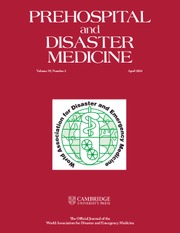Article contents
Comparison of Techniques for Securing the Endotracheal Tube while Wearing Chemical, Biological, Radiological, or Nuclear Protection: A Manikin Study
Published online by Cambridge University Press: 28 June 2012
Abstract
The objective of this study was to assess the impact of chemical, biological, radiological, nuclear personal protective equipment (CBRN-PPE) on the ability to secure an endotracheal tube (ETT) with either the Thomas Tube Holder™ or cotton tape tied in a knot.
Seventy-five clinicians secured an ETT in a previously intubated manikin with the Thomas Tube Holder™ and cotton tape. A mixed quantitative and qualitative research design was used to gauge actual performance times and perceptions of difficulties. Following completion of the study, 25 clinicians were interviewed to gauge their experiences of securing the ETT with both devices while wearing CBRN-PPE.
The mean time to apply the Thomas Tube Holder was 29.02 seconds, compared with tape which took a mean of 58 seconds (p = 0.001). Clinicians rated the Thomas Tube Holder as easier to use than tape (Mann-Whitney z = 9.934; p <0.001), which was confirmed during interviews. Of the clinicians interviewed, 92% perceived that the Thomas Tube Holder provided the better method for securing an ETT, none of the clinicians identified the tape as the best method for securing the endotracheal tube while wearing CBRN-PPE. Clinicians identified that the design of the Thomas Tube Holder facilitated the gross motor movement required for application.
The Thomas Tube Holder is easier and faster to apply when wearing CBRN-PPE when compared with cotton, and the Thomas Tube Holder is perceived by the participants as being more effective at preventing accidential extubation
- Type
- Equipment Evaluation
- Information
- Copyright
- Copyright © World Association for Disaster and Emergency Medicine 2010
References
- 7
- Cited by




